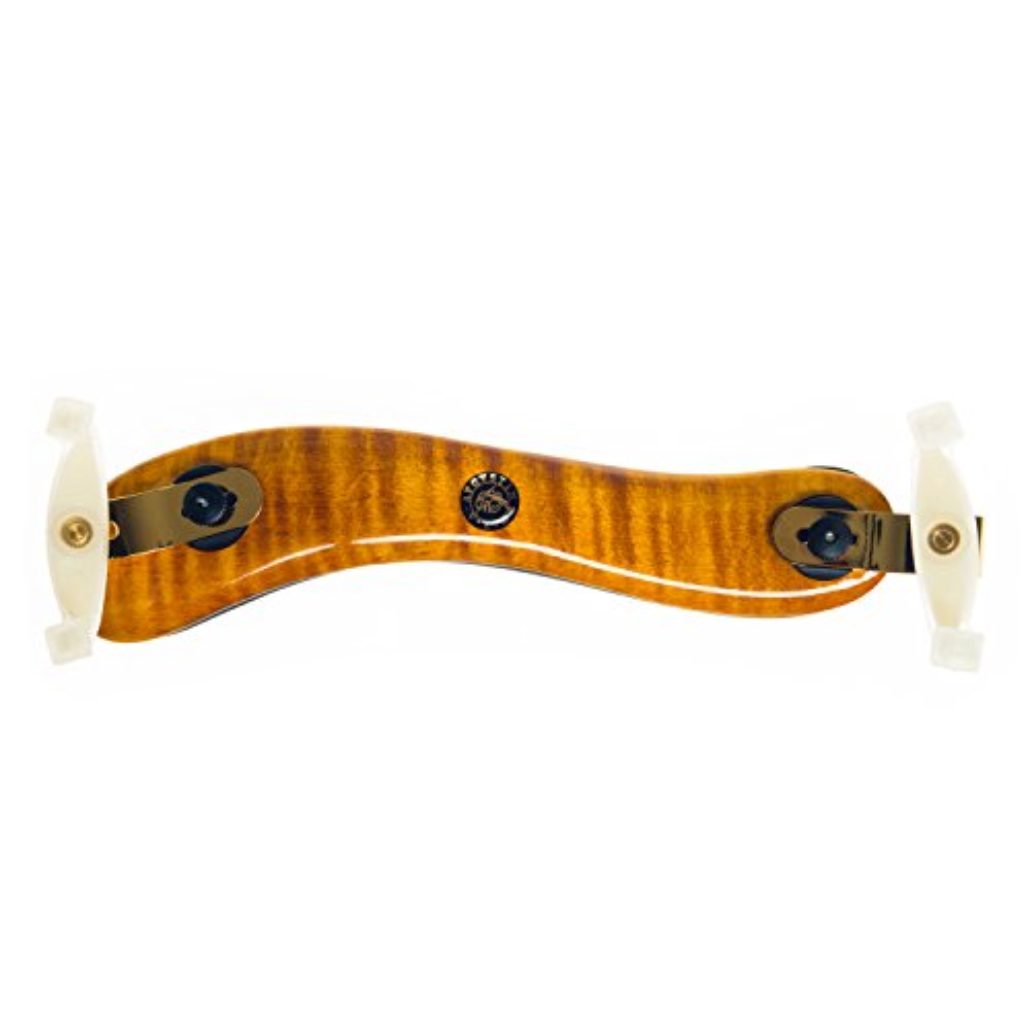Hot topic
Hello there friends! It’s time to talk about Violin shoulder rests. In the world of violin playing, shoulder rests are a relatively new thing. They made their debut during the 20th century and have been causing contention since the first one rolled off the line. You might ask, “But Sir, why are people in such hot dispute about shoulder rests?” To which I would respond, “Tradition!”
Ok, that’s not the full story. There’ s some very pertinent and logical stylistic considerations to make when you decide on whether or not you are going to play with a shoulder rest. If you exclusively play Renaissance, Baroque, and Classical era violin music and your goal is purity of style, then you will want to explore playing without a shoulder rest. Let’s talk about our requirements for a shoulder rest and then we can discuss brands that might work for you.
What do I get out of it?
I personally use a shoulder rest and I recommend that all of my students do as well. I find there is often more to gain from using a shoulder rest than there is to lose (when it comes to simply learning the instrument). There are some important considerations here.
First, I often find that a well-shaped shoulder rest can help usher in better left hand posture for any student. Second, I often see that using a shoulder rest helps the violin remain more stable and keep the violin in it’s optimal location. This is not universal, however. There are students that will require constant reminding on their posture. Honestly, that’s to be expected, so no worries there.
One size does not fit all
Finally, not all violin shoulder rests are created equal. When I say this, I mean that each one varies based on it’s design. I have specific opinions on shoulder rests and how I want them to contour my shoulder and the shoulders of my students. They should be able to hold on snuggly to the contour of the shoulder and the upper chest area, and follow the curve of the body around to the back. Depending on your body shape, as long as the shoulder rest cups to the upper part of your back, and supports the violin well on your front, you should be ok.
At the end of the day, we want the violin to be slightly slanted down toward the ground, but not vertical or close to vertical. This makes it more comfortable to change the level of your bowing elbow and thus, change strings. Also, at the end of the day, remember that your shoulder rest size (4/4, 3/4, 1/2, etc) should match the size of your violin.
Concerning design, violin shoulder rests come in many different forms. The main ones are foam, inflatable, and solid material. The foam shoulder rests are either held on by rubber bands, or are attached via adhesive. The inflatables are held on by rubber bands. The solid materials are generally attached by “feet” on the bottom of the shoulder rest.
The jury is still out on whether or not some of these methods can stop the vibrations that the violin produces and therefore mute some of the sound. This is one of the arguments against foam and inflatables and believe it or not, even foot-style attachments. However, some companies make products and claim they remove nothing from the resonance of the violin. You will also notice that many a professional violin soloist uses the foot-style attachments shoulder rests and to my ear, not much if anything is lost.
What it’s made of can matter
I’ll preface this section by saying, materials can be an important factor, but not necessarily game-changing if you’re a beginner. Most of the models a beginner will purchase will be made of plastic and foam. Still, there are others that use metal and wood. This mainly has to do with violin shoulder rests that are made of solid materials, are foot-style attachments, and contour the shoulder.
Plastic can be somewhat malleable, depending on it’s thickness and can therefore bend slightly. This can be a positive or a negative when it comes to comfortability. They are usually padded with soft plastic foam. Most of the shoulder rests within the budget range will have these identifying factors. I personally use one of this type. Not exactly plastic but similar is carbon fiber. The differentiating characteristic with carbon fiber is that it is very light and can be made to be much more rigid than conventional plastic.
Some companies use a metal in constructing their beams (the part that touches the shoulder). This can be for increased rigidity, or in some cases, to allow the user to mold the beam to fit their shoulder. It’s always nice to have a way to personalize the comfort that your shoulder rest affords you. In application, I find good things with shoulder rests of metal construction. My only issue can be (but other shoulder rests present this as well), whether or not the metal used is particularly heavy. I like a light shoulder rest, but there’s something to be said for the stability afforded by extra weight. That is, as long as it’s not too exorbitant.
The last beam-construction material I’ll mention is wood. This is probably the most beautiful and aesthetically pleasing material of all. It is also, most often, the most rigid (although metal wins out sometimes). Some violinists like to have a consistent, unchanging shape from their shoulder rest. If that is your goal, wood is very effective. You always know what you’re going to get. But the trade off is that you can’t necessarily tailor it to your shoulder.
Still, I’ve not had many issues with the need to personalize my rest as these shoulder rests are on the more expensive side and therefore the companies put a lot of research into ergonomics and making it feel good on your shoulder. Additionally, wood construction can add to the resonance of your violin and projection of your sound.
Now that we’ve gone through what to look for, let’s take a look at some options if you’re in need of a new shoulder rest.
Everest
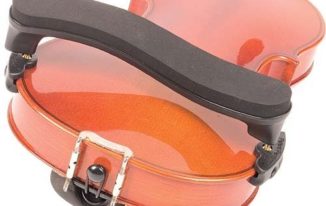
As an instructor, I have suggested this specific violin shoulder rest to my students countless times. For starters, it’s relatively stable, as economy class shoulder rests go. It does have some measure of reinforcement at locations on the shoulder rest that typically break. The padding on this shoulder rest is nice as well.
This shoulder rest is entirely made of synthetic materials. This allows for some positives and some negatives. First, it’s very light. I hardly notice it on a violin other than to acknowledge the support it provides. Second, you’re not paying the price that wood or an extensive amount of metal commands. The “feet” by which the shoulder rest uses to attach are heavy-duty.
I find that the curve on this shoulder rest is one of the best in the economy range of shoulder rests. My students that have used other shoulder rests that are of equal or lesser value report that the Everest is the clear winner in comfort and contour of the shoulder. The contour is important. I’ve found that a good counter of the shoulder allows the shoulder rest to almost “latch on” to the shoulder and therefore not allow for much movement unless the violinist expressly moves the instrument. This is actually a big positive.
On the negative side of things, though there have been measures taken to reinforce certain parts of the shoulder rest, the Everest suffers from a slight malfunction rate. There are reports of the unit breaking, but in truth, this is a relatively small chance. In the years that I’ve been suggesting this product, I have yet to see a malfunction. It’s not quite as adjustable as some of the other products on this list, and as such, it’s not great for left-handed players.
Pros:
- Economical
- Light
- Sturdy Construction
- Comfortable (for right-handed players)
- Heavy-duty “feet” attachments
Cons:
- Limited reports of malfunction
- Limited adjustability
- Not great for left-handed players
[button-green url=”http://amzn.to/2kkDctA” target=”” position=””]Buy At Amazon[/button-green]
Kun – Original
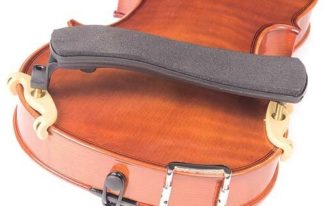
I have been using the Kun Original shoulder rest since I took off my first sponge shoulder rest. That’s been more than a few years. The Kun Original was good then, and it’s great now. The company has worked to improve this model in any way they can, and have been met with success.
For starters, this shoulder rest has a good amount of adjustability. You can adjust the location of the feet, the height of the feet, and the angle of the feet. This allows the shoulder rest to accommodate a variety of body shapes and characteristics.
There is a reasonable amount of padding on the beam. The Kun Original is made of synthetic materials along with metal. However, a great plus is that there is very little metal exposed. The feet of the shoulder rest allow for none of the metal to touch your instrument. This is a big plus. One of the things Kun has done successfully is find a material and method by which they cover the feet in the most complete and effective way.
On the negative side of things, though there is a reasonable amount of padding on the beam, it’s not as much as other violin shoulder rests you’ll find. Additionally, the beam contour is not quite as pronounced as other shoulder rests. Depending on your body contour, this can be a problem. I have noticed that, if you happen to be particularly thin, the Kun Original might not offer enough contour and adjustability to accommodate your frame.
The Kun Original is relatively economical. It is not the least expensive on this list, but it is certainly not the most expensive. Additionally, as a left-handed player, I can say that this shoulder rest also works wonderfully for me. If you’re looking for an upgrade from a beginner shoulder rest, this is a good option.
Pros:
- Relatively economical
- Light
- Sturdy construction
- Comfortable for both right-handed and left-handed players
- No exposed metal on feet
- Good adjustability
Cons:
- Padding is less than competitor’s
- Beam contour is not as pronounced as competitor’s
- May not work well for especially thin individuals
Fiddlerman Wood Violin Shoulder Rest
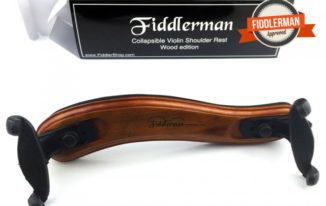
The Fiddlerman Wood Violin Shoulder Rest is a wooden shoulder rest at a great price. For starters, the feet are fully adjustable to fit your body and your violin. There’s a good amount of range for the rest as well. It’s nothing earth shattering, but for all but the thinnest individuals, you should be able to find your required foot height.
The feet are fully covered so that your violin doesn’t touch any exposed metal, which avoids potential scratches. The feet also lower more than other shoulder rests in this class of accessory.
While the feet are metal, covered in a synthetic, the beam of the shoulder rest is true wood. It has a nice finish with the Fiddlerman logo etched in it. No stickers here, folks, this is all natural. Admittedly, this is more aesthetic than anything. However, since this shoulder rest performs well in all other areas, aesthetics can be examined and here, you simply can’t go wrong.
The foam padding on this shoulder rest is nice and comfortable. But more than this, the shoulder rest has a wave motion to it. This allows for a more diagonal line across the upper chest. This adds both to comfort and stability.
This shoulder rest is made of wood, and to many players, having a wooden beam adds to the resonance of your instrument. What is certain is that the smaller profile of the feet allows for less sound dampening on your instrument, which is a big plus. Another big plus is the world famous customer support from Fiddlerman. In my dealings with Fiddlerman, I’ve always received the best of service and I know you will receive the same.
On the negative side of things, the wood is not of the highest quality. What I mean is that it’s not hewn from the hallowed forests of Germany or Italy. However, if that were the case, this rest would be triple or quadruple the price.
Sometimes a unit is shipped missing a piece or slightly damaged from transit. However, with Fiddlerman’s stellar service, these problems are easily remedied.
Some individuals have reported malfunctions of the unit after months of use. This can be annoying. However, this is somewhat common throughout units of this price range. I have used several shoulder rests in this price range and if taken care of, any brand shoulder rest can last years.
Pros:
- Relatively economical
- Light
- Sturdy construction
- Comfortable for both right and left-handed players
- No exposed metal on feet
- Good adjustability
- Wood construction for resonance
- Good quality to price ratio
- Comes with famous Fiddlerman customer service
Cons
- May not work well for especially thin individuals
- Not a harvested hard wood
- Limited reports of malfunction
- Limited reports of product anomalies due to shipping
Viva La Musica Diamond Shoulder Rest
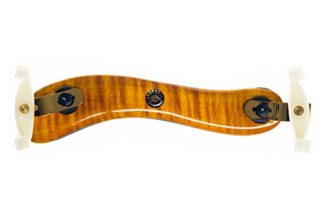
This shoulder rest is the most expensive on our list but it has some wonderful amenities to consider. First, this is a true, one-piece harvested Bosnian flamed maple. This is the same type of wood as most violins. This will help the violin to resonate more thoroughly. Additionally, the feet of this shoulder rest are low profile so as to not absorb or impede on any of the natural vibrations produced by your violin, thus adding to resonance.
This shoulder rest benefits individuals in that it is fully adjustable in some ways that other shoulder rests are not capable of. For example, the arms are made entirely of metal and they can swing 360 degrees to allow you to send the shoulder rest closer to the back of the violin while maintaining the feet at the widest point of the lower bout. The feet are fully covered by soft synthetic materials so no metal is exposed and does not hurt your instrument.
This shoulder rest also has larger and shorter foot screws available that allow for extended height adjustments. It will adjust to fit nearly anyone’s needs. This shoulder rest has a substantial curve that allows the unit a more diagonal angle on the body that adds to comfort and stability.
Concerning comfort, the padding on this shoulder rest is not exorbitant, but feels very nice on the shoulder. This rest is not quite as long as others on this list, but that also allows for a lower profile that will in turn, be more comfortable.
This shoulder rest is a very tough unit. Being solid wood, the beam will stay intact for quite a while due to it’s solid wood construction. The fittings are all metal and therefore, should hold well, but if there were a malfunction, it would likely be in this area.
On the negative side of things, we clearly have to cite the price. It’s by no means insurmountable as classical instrument accessories go. However, it is three to four times the price of the most inexpensive rest on this list. This shoulder rest does not rotate as other rests on this list and therefore, does not allow for full accommodation for left-handed players. However, it sits flat and therefore allows for a uniform 180 degree flip to allow left-handed players to use it.
Pros:
- Very light
- Very sturdy construction
- No exposed metal on feet
- Very good adjustability
- Solid flamed maple wood construction for resonance
- High quality
Cons:
- Higher price
- Limited accommodation for left-handed players
Final Thoughts
Shoulder rests come in so many different brands, colors, shapes and sizes that sifting through them all can be a daunting task. Remember to always get a shoulder rest specific to your violin size (4/4, 3/4, 1/2, etc). We had fun compiling this list and we hope this information helps you make the best choice for you!
